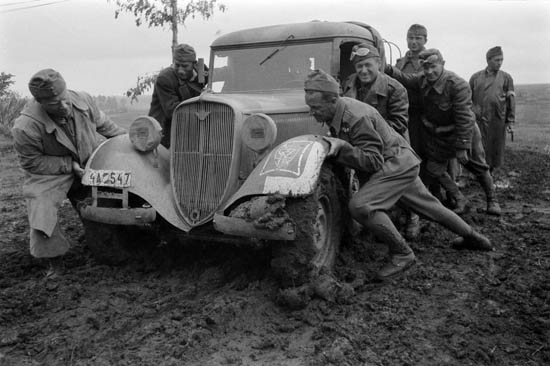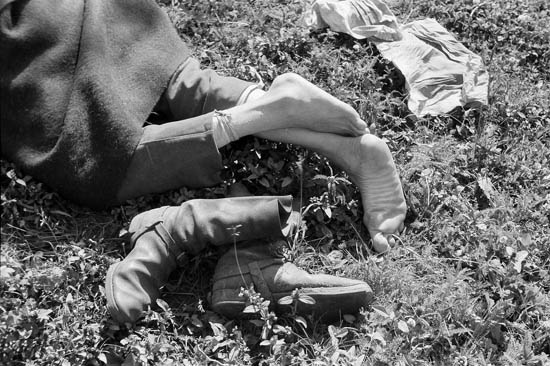
The exhibition documents the fate of the 2nd Hungarian Army, sent to the Don Bend against the Red Army, from their leaving in April 1942 through the Voronezh breakthrough of the Red Army – just seventy years ago, on January 12, 1943 – until the return of the surviving soldiers in April 1943.
This one year is followed by the circle of the exhibition starting at the entrance and returning there, on which the documents run in five parallel stripes. The light stripe in the middle illustrate the events with press photos and written documents, which are counterpointed by the headers of the articles of the period in the lowest stripe. Above the light stripe, the media representation of the period, street posters and propaganda materials. And at the top, a stunning series of photographs from Russia, now exhibited for the first time, by Major Tamás Konok Sr., a commander of the war correspondent unit – perhaps too high in sight of their importance and of the large empty space left under them. And between the light stripe and the lower press header section, there runs already a next circle of time: press documents and texts following up the afterlife and interpretations of the tragedy between 1947, from the show trial of the commander in chief Gusztáv Jányi, through the history books of the Communist period and the press reception of the works interpreting the events to the statements published since 1990. At the corners of the exhibition panels one can listen to the Hungarian, German and Russian newsreels of the period. And in the middle, where the panels open up, the memoirs of the former survivors follow each other on the screen from Sándor Sára’s movie Pergőtűz (Drumfire), which was recorded in 1982, but they could publicly project it only after the change of regime, and the book version of the memoirs were also pulped shortly after their publication. The script of the exhibition writes about this film:
“For a brief historical moment it seemed, that the monumental documentary by Sándor Sára and Sándor Csoóri, the Chronicle, and its movie version Drumfire can fulfill the same function which the Vietnam Memorial Monument in Washington, erected at about the same time, managed to fulfill to everyone’s surprise. The American public, which was extremely divided in the question of the Vietnam War, both they who considered it an unlawful, colonial and inhuman adventure, and they who – similarly to the Hungarian right wing’s interpretation of the country’s participation in WWII – saw in it a crusade against communism, could agree in front of the monument in the fact that the war was a common tragedy. A tragedy both to those who fled from compulsory military service, and those who returned wounded from the theater of war of Vietnam. The memorial of the 21-year old Chinese-American only shows names: the names of 58 272 dead and missing soldiers, not in alphabetical order, but following the chronology of the war.
The film of Sándor Sára, independently from the ideological and political, and – partly – even from the historical context, has intended to dig out the common – almost timeless – tragedy of the common people from silence, forgetfulness, indifference and humiliation, and to heal the historical wounds by understanding the common tragedy.”

The greatest sensation of the exhibition, however, is undoubtedly the photo series by war correspondent Major Tamás Konok Sr., provided at the disposal of the exibition by his son, the outstanding master of Hungarian avant-garde Tamás Konok, Jr.
 “Major Tamás Konok (1898-1970). The passionate amateur photographer has two Leicas
“Major Tamás Konok (1898-1970). The passionate amateur photographer has two Leicasin the neck, one to shoot black and white, the other color pictures. The latter
was a then top category C3 camera, which came out in 1938.”
(Photo and caption: index nagykép)
Tamás Konok was born in Kisgaram (today Hronec in Slovakia) on December 18, 1898 in a poor civil servant family. He was interested in music, but the family’s financial circumstances did not allow him to study at the Conservatory. Thus he went to the military academy, which was free for the sons of state employees, in 1922 he was inaugurated lieutenant. In 1928 he married the daughter of the renowned architec and passionate photographer Gyula Sándy: this was probably the source of his interest in photography. In 1937 he joined the national association of Hungarian amateur photographers, and he learned on photography everything that could be known in the period. In 1942 he was appointed one of the commanders of the war reporter unit, and was on the Eastern front from June to December. The photos preserved in his bequest do not represent primarily the war, but rather the Ukrainian and Russian landscape and people, and the everyday life of the soldiers. So much, that in 1943, after the Don catastrophe, his Russian portraits included with the label “We fight against these” in the representative exhibition in the Redoute were removed after some days, in spite of the positive professional criticism, because they represented too sympathetic the Russian peasants and prisoners of war.
From January 1944 he became the commander of the 16/I Battalion of Győr. After the German occupation, as a well-known anti-German senior officer, he was ordered again to the Eastern Front. After the Hungarian Nazi takeover in October 1944, he did not take an oath to the Nazi leader Szálasi, thus he was sentenced to death in absentia. In January 1945, together with a part of his soldiers, he defected to the Soviet troops, and went to Debrecen, already under Soviet occupation, where he reported himself at the Provisional Democratic Government for fighting again Germany. After the war he returned to Győr, where he became the city’s military commander. As he did not join the Communist Party, in November 1947 he was dismissed, and was also denied a pension. Then, at the age of 50 he enrolled in a technical school, where he made a master photographer’s exam, and opened a modest photo studio. In 1968 he retired, and died two years later (A brief summary of his biography at the exhibition)
A part of the exhibited photos of Tamás Konok Sr. (as well as some unexhibited ones) were published in the leading Hungarian portal Index on the occasion of the opening ceremony. I also take them over, not as if they could not be seen over there, but so that the non-Hungarian readers of Río Wang could see them together with the translation of their captions.
 After the advent of the rainy season it was increasingly difficult to advance. Here they attempt to pull out a jammed Opel from the mud
After the advent of the rainy season it was increasingly difficult to advance. Here they attempt to pull out a jammed Opel from the mud



























































No hay comentarios:
Publicar un comentario